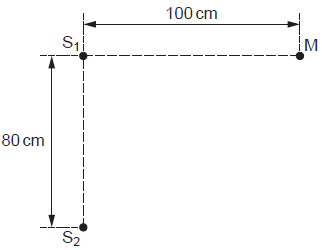Question 13
Two sources S1 and
S2 of sound are situated 80 cm apart in
air, as shown in Fig. 5.1.
Fig. 5.1
The frequency of vibration can be varied. The two sources
always vibrate in phase but have different amplitudes of vibration.
A microphone M is situated a distance 100 cm from S1 along a line that is normal to S1S2.
As the frequency of S1 and
S2 is gradually increased, the microphone
M detects maxima and minima of intensity of sound.
(a) State the two conditions that must be satisfied for the
intensity of sound at M to be
zero. [2]
(b) The speed of sound in air is 330 m s-1.
The frequency of the sound from S1 and S2 is
increased. Determine the number of
minima that will be detected at M as the frequency is
increased from 1.0 kHz to 4.0 kHz. [4]
Reference: Past Exam Paper – June 2009 Paper 21 Q5
Solution:
(a)
{The intensity of the
sound at M is zero when destructive interference occurs.}
Condition 1: EITHER the phase difference is π rad / 180°
(anti-phase)
OR path difference (between the waves
from S1 and S2) is ½ λ / (n + ½) λ
Condition 2: EITHER the waves have the same amplitude /
intensity at M
{Destructive interference
occurs and the resultant amplitude is zero.
Let amplitude of each wave
be A. For destructive interference, resultant amplitude = A – A = 0
BUT if the amplitude of
one wave is A and the amplitude of the other is 0.5A. Resultant amplitude = A –
0.5A = 0.5A. The resultant amplitude is NOT zero.
So, for destructive
interference, the waves should have the SAME amplitude.}
OR the ratio of amplitudes is 1.28 /
ratio of intensities is 1.282
{From
Pythagoras’ theorem, the distance S2M is 128 cm.
Note
that the amplitudes of the waves decrease as they travel over distances since
they lose energy.
So, the
ratio of amplitudes should be 128 / 100 = 1.28 such that the waves would have
the same amplitude at point M (even though they are emitted at different
amplitudes at S1 and S2).
Intensity
∝ (amplitude)2
So,
the ratio of intensities = (ratio of amplitudes)2 = 1.282
}
(b)
Path difference between
the waves from S1 and S2 = (128 – 100 =) 28 cm
{v = f λ
when frequency = 1 kHz,
wavelength = 330 / 1000 = 0.33 m = 33 cm
when frequency = 4kHz,
wavelength = 330 / 4000 = 0.0825 m = 8.25 cm}
The wavelength changes
from 33 cm to 8.25 cm {as the frequency is increased}
{Condition for destructive
interference:
path difference = (n + ½) λ
(n + ½) λ = 28
Wavelength λ = 28 / (n +
½)
When n = 0, λ = 56 cm {but this is outside the range}
When n = 1, λ = 18.7 cm {within range}
When n = 2, λ = 11.2 cm {within range}
When n = 3, λ = 8.0 cm {but this is outside the range}
Minima will be detected
when λ = (56cm,) 18.7cm, 11.2cm, (8.0cm).
So, there are 2 minima. {that are within the range}


Thanks a lot
ReplyDeleteThank you !
ReplyDeleteThanks a lot !!
ReplyDelete